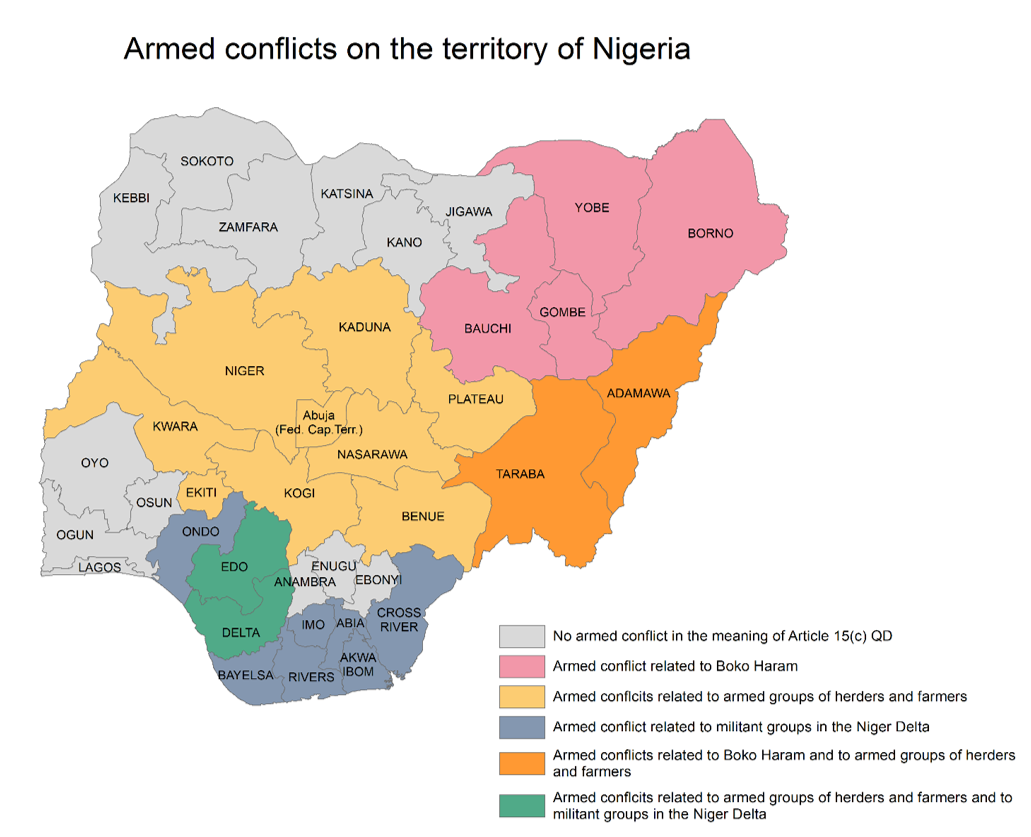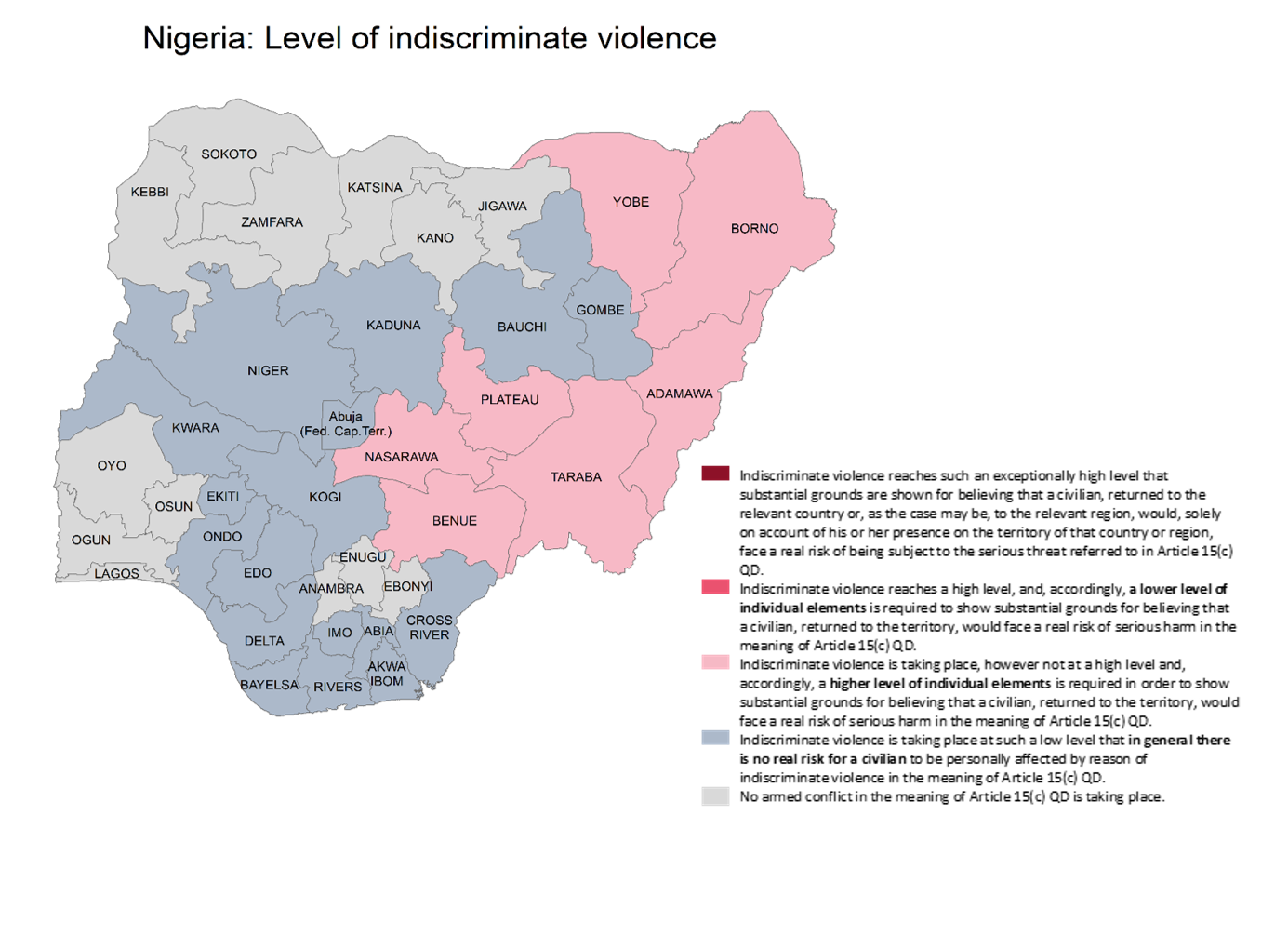GUIDANCE NOTE
Last updated: February 2019
Serious and individual threat to a civilian’s life or person by reason of indiscriminate violence in situations of international or internal armed conflict
The necessary elements in order to apply Article 15(c) QD are:

Figure 3. Article 15(c) QD: elements of the assessment.
| |
In order to apply Article 15(c) QD the above elements should be established cumulatively.

The following is a summary of the relevant conclusions concerning the situation in Nigeria:
a. Armed conflict:
Applying the low threshold introduced with the Diakité judgment, it is found that several armed conflicts in the meaning of Article 15(c) QD take place in Nigeria, in particular on the territory of the following states: Abia, Adamawa, Akwa Ibom, Bauchi, Bayelsa, Benue, Borno, Cross River, Delta, Edo, Ekiti, Gombe, Imo, Kaduna, Kogi, Kwara, Nasarawa, Niger, Ondo, Plateau, Rivers, Taraba, Yobe, as well as the Federal Capital Territory of Abuja.
These armed conflicts are presented in the map below.

Figure 4. Armed conflicts on the territory of Nigeria (based on data as of September 2018).
| |

b. Civilian: Article 15(c) QD applies to a person who is not a member of any of the parties to the conflict and is not taking part in the hostilities, potentially including former combatants who have genuinely and permanently renounced armed activity. The applications by persons under the following profiles should be examined carefully. Based on an individual assessment, such applicants may be found not to qualify as civilians under
Article 15(c) QD. For example:
■ Boko Haram members
■ Members of armed groups of farmers or herders
■ Militant groups in the Niger Delta
■ Members of the CJTF
■ National security forces, including NAF, the Nigerian Navy, the Nigerian Air Force, and NPF.
It should be noted that actively taking part in hostilities is not limited to openly carrying arms, but could also include substantial logistical and/or administrative support to combatants.
It is important to underline that the assessment of protection needs is forward-looking. Therefore, the main issue at hand is whether the applicant will be a civilian or not upon return. The fact that the person took part in hostilities in the past would not necessarily mean that Article 15(c) QD would not be applicable to him or her. For example, the assessment should further take into account whether the person had voluntarily taken part in the armed conflict; those who willingly joined the armed groups are unlikely to be considered civilians.

c. Indiscriminate violence: Indiscriminate violence takes place to a different degree in different parts of the territory of Nigeria. The map below summarises and illustrates the assessment of indiscriminate violence per state in Nigeria, as well as the Federal Capital Territory of Abuja. This assessment is based on a holistic analysis, including quantitative and qualitative information for the reference period (generally, October 2017 – September 2018). Up-to-date country of origin information should always inform the individual assessment.

Figure 5. Level of indiscriminate violence in a situation of armed conflict in Nigeria (based on data as of September 2018).
| |
It should be noted that there are no states in Nigeria where the degree of indiscriminate violence reaches such a high level that substantial grounds are shown for believing that a civilian, returned to the relevant country or, as the case may be, to the relevant region, would, solely on account of his or her presence on the territory of that country or region, face a real risk of being subject to the serious threat referred to in Article 15(c) QD.
For the purposes of the guidance note, the territories of Nigeria are categorised as follows:


d. Serious and individual threat: Certain applicants may be considered at enhanced risk of indiscriminate violence, including its direct and indirect consequences due to, inter alia: geographical proximity to areas which are targeted by violence, age, gender, health condition and disabilities, lack of a social network, etc.
Profiles at enhanced risk of indiscriminate violence could include, for example:
■Civilians who may be substantially and materially affected by violence because of their geographical proximity to a possible target (e.g. those living in proximity to known Boko Haram targets, such as markets, schools, hospitals, religious buildings, IDP camps, military bases; those living in villages of farmers or herders’ communities in the LGAs particularly affected by the violence between herders and farmers).
■ Civilians who are less able to avoid risks of indiscriminate violence by way of seeking temporary shelter from fighting or attacks (e.g. persons with disabilities or serious illnesses; elderly; children; those in an extremely dire economic situation).

e. Threat to life or person: The risk of harm as per Article 15(c) QD is formulated as a ‘threat to a civilian’s life or person’ rather than as a (threat of) a specific act of violence. Some of the commonly reported types of harm to a civilian’s life or person in Nigeria include killings, injuries, abductions, forced displacement, rape, famine caused by food insecurity, etc. The assessment of the harm should be forward-looking.

f. Nexus:The nexus ‘by reason of’ refers to the causal link between the indiscriminate violence and the harm (serious threat to a civilian´s life or person) and includes:
■ Harm which is directly caused by the indiscriminate violence or by acts that emanate from the actors in the conflict, and
■ Harm which is indirectly caused by the indiscriminate violence in a situation of armed conflict. Indirect effects are only considered to a certain extent and as long as there is a demonstrable link with the indiscriminate violence, for example: widespread criminal violence as a result of a complete breakdown of law and order, destruction of the necessary means to survive. Armed clashes and/or closure or destruction of roads can also lead to food supply problems that cause famine or to limited or no access to healthcare facilities in certain areas of Nigeria.







